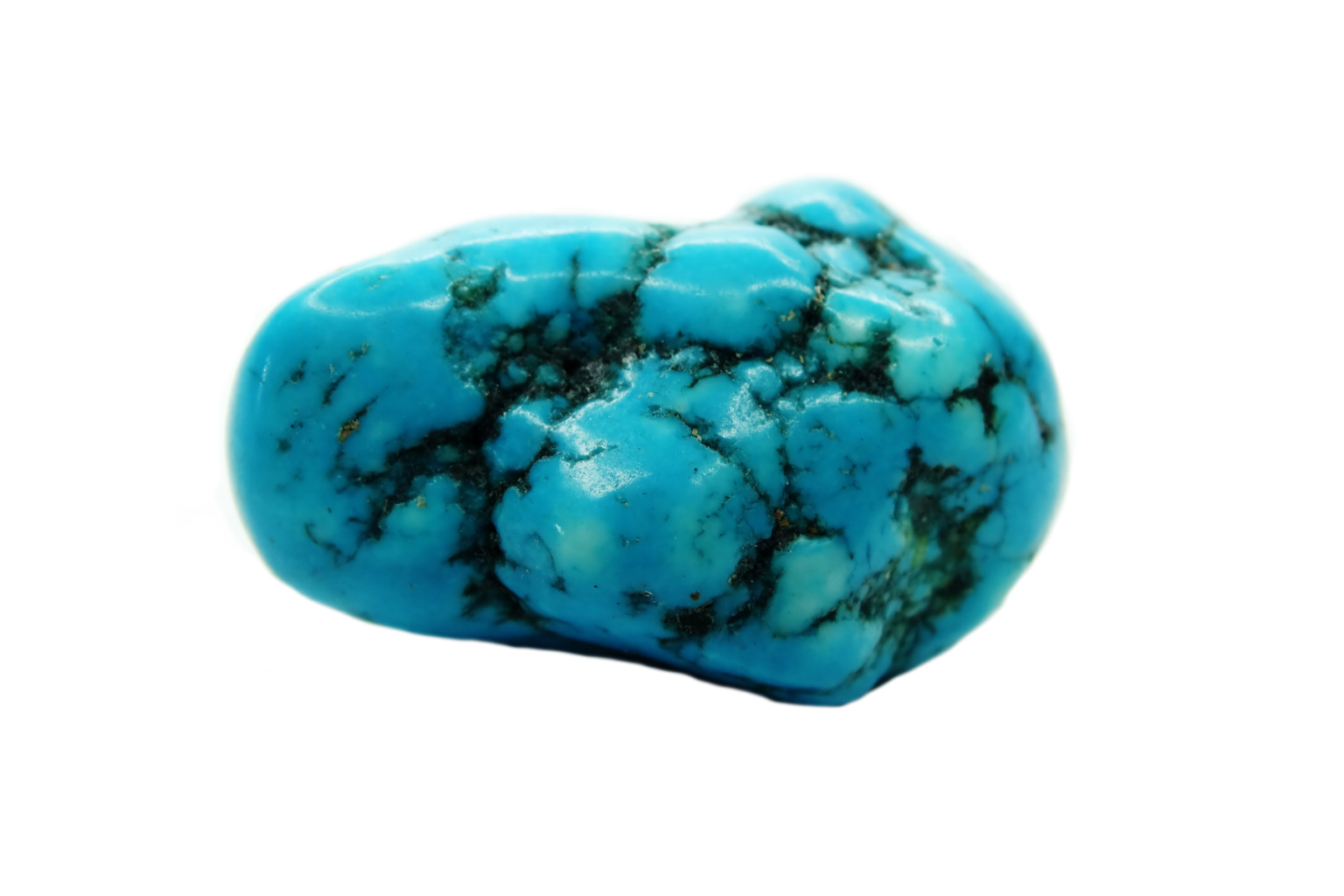Turquoise is a highly valued and distinctive mineral that has been used for thousands of years for its cultural and spiritual significance. From ancient Egypt to Native American cultures, turquoise has been highly regarded for its beauty, durability, and protective and healing properties.
Appearance
Turquoise is a mineral that is known for its distinctive blue-green color, which can range from pale sky blue to deep green-blue. The color of turquoise is due to the presence of copper and other minerals in the stone.
Turquoise often has a waxy or dull surface and can be opaque or translucent. It has a hardness of 5 to 6 on the Mohs scale, which means that it is relatively soft compared to other minerals. Turquoise is typically found in nodules or veins and can have a mottled appearance due to the presence of matrix, which is the surrounding rock that is included in the turquoise.
The matrix can appear as brown, black, or grey veins or patches that create a web-like pattern on the surface of the stone. The presence and appearance of matrix can affect the value and desirability of turquoise. High-quality turquoise is typically bright, uniform in color, and free of matrix, while lower-quality turquoise may have a duller color and more prominent matrix.
The Chakra Associated with Turquoise
Turquoise is a mineral that is known for its distinctive blue-green color, which can range from pale sky blue to deep green-blue. The color of turquoise is due to the presence of copper and other minerals in the stone.
Turquoise often has a waxy or dull surface and can be opaque or translucent. It has a hardness of 5 to 6 on the Mohs scale, which means that it is relatively soft compared to other minerals. Turquoise is typically found in nodules or veins and can have a mottled appearance due to the presence of matrix, which is the surrounding rock that is included in the turquoise.
The matrix can appear as brown, black, or grey veins or patches that create a web-like pattern on the surface of the stone. The presence and appearance of matrix can affect the value and desirability of turquoise. High-quality turquoise is typically bright, uniform in color, and free of matrix, while lower-quality turquoise may have a duller color and more prominent matrix.
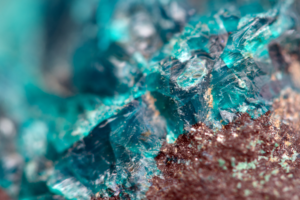 Cleansing Methods for Turquoise
Cleansing Methods for Turquoise
There are several alternative methods to cleanse and recharge turquoise:
- Smudging: You can cleanse turquoise by smudging it with sage, palo santo, or other cleansing herbs. Simply light the herbs and allow the smoke to pass over the stone, setting the intention to clear away any negative energy.
- Sunlight or moonlight: You can also cleanse turquoise by placing it in direct sunlight or moonlight for several hours. This is believed to recharge the stone with positive energy.
- Clear quartz: Clear quartz is a powerful cleansing and amplifying stone, and can be used to cleanse and recharge other stones, including turquoise. Simply place the turquoise on a piece of clear quartz overnight or for several hours.
- Earth: Some people believe that burying turquoise in the earth can help to cleanse and recharge it. This is thought to help the stone connect with the natural energies of the earth.
The Healing Properties of Turquoise
Turquoise is believed by some to have various healing properties that can support physical, emotional, and spiritual well-being. Here are some of the common healing properties associated with turquoise:
- Physical healing: Turquoise is believed to have properties that can support physical healing and well-being. It is thought to help with detoxification, strengthening the immune system, and reducing inflammation and pain. It is also believed to support the respiratory system, including the lungs and throat.
- Emotional healing: Turquoise is believed to have properties that can support emotional healing and balance. It is thought to help with stress, anxiety, and depression, and promote a sense of inner peace and calm. It is also believed to help with communication and self-expression, and promote positive relationships.
- Spiritual healing: Turquoise is believed to have properties that can support spiritual growth and healing. It is thought to help with meditation, intuition, and insight, and promote a deeper connection to the spiritual realm. It is also believed to protect against negative energy and promote spiritual awareness.
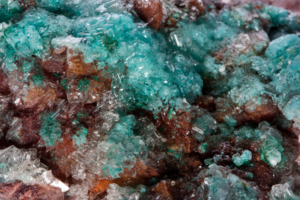
Harnessing Its Energy
here are various ways to harness the energy of turquoise, depending on the individual’s beliefs and practices. Here are some examples:
- Wearing turquoise jewelry: Wearing turquoise jewelry, such as necklaces, bracelets, or earrings, can allow the energy of the stone to be in close contact with the body throughout the day. This can help to activate and balance the throat chakra and promote overall well-being.
- Meditating with turquoise: Meditating with turquoise can help to enhance spiritual awareness and insight. Simply hold a piece of turquoise in your hand or place it on your third eye chakra (located between the eyebrows) while meditating.
- Placing turquoise in the home: Placing turquoise in the home, such as in a decorative bowl or on a shelf, can help to promote a positive and peaceful energy in the space.
- Using turquoise in healing rituals: Turquoise can be used in healing rituals, such as placing it on a particular area of the body that needs healing or using it in a crystal grid with other stones.
- Receiving a turquoise energy healing: Some energy healers may use turquoise as part of their healing practice, such as placing it on or around the body during a Reiki session.
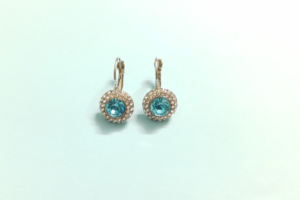 Turquoise’s History
Turquoise’s History
Turquoise has a long and fascinating history that spans thousands of years and multiple cultures around the world. Here are some key highlights from the history of turquoise:
- Ancient Egypt: Turquoise was highly valued in ancient Egypt, where it was used for jewelry, amulets, and other decorative objects. It was often inscribed with magical symbols and hieroglyphs, and was believed to have protective and healing properties.
- Native American cultures: Turquoise has been used by many Native American cultures for thousands of years for its spiritual, cultural, and practical significance. It is often used in jewelry, pottery, and other decorative objects, and is believed to have protective and healing properties. Turquoise is also a sacred stone that is often used in ceremonies and spiritual practices.
- Persia: Turquoise has been highly valued in Persia (modern-day Iran) for thousands of years. It was used for jewelry, decorative objects, and architectural embellishments, and was often associated with royalty and nobility. It was also believed to have protective and healing properties.
- China: Turquoise has been used in China for over 3,000 years and was highly valued for its beauty and cultural significance. It was often used in jewelry, carvings, and other decorative objects, and was believed to have protective and healing properties.
- Modern times: Turquoise remains a popular material for jewelry, especially in the southwestern United States. It is also used in fashion and interior design, and is often associated with the bohemian and hippie subcultures.
Throughout its history, turquoise has been associated with a wide range of beliefs and properties, including protection, healing, spiritual growth, and creativity. These beliefs and associations have evolved over time and vary depending on the culture, tradition, or spiritual practice.
Turquoise Care
Turquoise is a relatively durable stone, but it still requires proper care to maintain its beauty and integrity over time. Here are some tips for taking care of turquoise:
- Avoid exposure to water: Turquoise should be kept away from water, as it can damage the stone over time and alter its color or texture.
- Avoid exposure to chemicals: Turquoise should be kept away from chemicals such as perfume, hairspray, and cleaning products, as they can damage the stone.
- Store properly: Turquoise should be stored separately from other jewelry to avoid scratches or damage. It is best to store it in a soft pouch or wrapped in a soft cloth.
- Clean gently: To clean turquoise, use a soft, damp cloth to gently wipe away any dirt or dust. Avoid using harsh chemicals or abrasives, as they can damage the stone.
- Recharge regularly: Turquoise can be recharged by placing it in sunlight or moonlight for several hours. This is believed to recharge the stone with positive energy.
- Handle with care: Turquoise is relatively soft compared to other stones and can be easily scratched or damaged. Handle it with care and avoid dropping or knocking it against hard surfaces.
By following these care tips, you can help to preserve the beauty and integrity of your turquoise jewelry or other decorative objects for years to come.
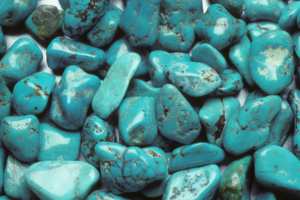 Summary
Summary
Turquoise is a beautiful blue-green mineral that has been used for thousands of years for its cultural and spiritual significance. From ancient Egypt to Native American cultures, turquoise has been highly regarded for its beauty, durability, and protective and healing properties. Turquoise is often associated with the throat chakra and is believed to help activate and balance this chakra, promoting clear communication, self-expression, and creativity. It is also believed to have various healing properties that can support physical, emotional, and spiritual well-being. Proper care of turquoise is important to maintain its beauty and integrity over time.

